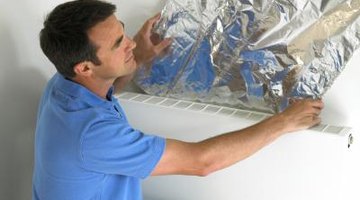Is Kitchen Aluminum Foil the Same as a Foil Radiant Barrier?
Since 1913, aluminum foil has proved an ideal material for use in household and industrial applications. Thanks to methods that layer thin sheets of aluminum together until a desired thickness is achieved, foils are manufactured in different thicknesses and large quantities. Regardless of use, aluminum foils are among the most durable and recyclable products made.
Aluminum Manufacturing

Alumina, produced from bauxite ore, is converted into molten aluminum through a series of steps involving electrolytic cell processes. It is then cast into ingots of aluminum that are rolled into coils, which are processed and rolled into sheets. Regardless of its final application, aluminum foil is 99.45-percent pure aluminum. Thickness varies, but is generally between 0.125 inches to 0.250 inches in thickness. The 27 international manufacturers who belong to the International Aluminum Institute (world-aluminium.org) are responsible for 80 percent of the world’s aluminum production.
About Reflective Foils
There are two sides to aluminum foil: a shiny side and a dull side. Both sides are equally reflective; the shiny side results from exposure to the rollers used in the pressing process. Aluminum foil reflects heat back to the source that the heat originates from. When used as a barrier outside on a sunny day, for example, the foil reflects the heat from the sun back toward the sky. Reflective foils are an important part of removing radiant heat from an attic, but aluminum foil made for kitchen use is not the same as a commercially produced radiant heat barrier.
Kitchen Foils
Although the practice is not considered mainstream, many households do use kitchen foil to cover windows that are exposed to lots of summer sun. In instances where the surface to be covered is small and easily reached, is covered temporarily and does not require more than a couple of rolls, high-quality aluminum kitchen foil can be an inexpensive money-saver. It is not an effective use of time or money, however, to purchase enough rolls of household-grade aluminum foil to cover an attic. Kitchen-grade aluminum foil tears easily, breaks down in time due to added alloys and minerals, does not keep heated or cooled air from escaping and can form a vapor barrier trapping moisture between the foil and the insulation. Kitchen foils are relatively narrow; Reynolds Wrap Super Strength Aluminum Foil is 18 inches wide and 50 feet long.
Radiant Foil Barriers
Radiant foil barriers are designed as double-sided multi-layered foils that are easily installed by homeowners or professionals over an attic’s existing insulation. In addition to reflecting the sun’s rays, these barriers prevent interior heat or air-conditioning from escaping through the roof. Foils made by Enerflex Radiant Barrier (enerflexfoil.com), AtticFoil (atticfoil.com) and Energy Improvements (energyimprovements.net) are guaranteed, do not tear when stapled or poked, are perforated to prevent a vapor barrier from forming and come in widths wide enough to span beams and rafters. AtticFoil is 48 inches wide and is available in rolls 125 feet or 250 feet long.
References
Resources
Writer Bio
Karen Sweeny-Justice is a writer living in Surprise, Ariz. Her work has appeared in "Writer's Digest" magazine and "RubberStampMadness" magazine, as well as in newspapers around the United States. She also writes book reviews for "RT Book Reviews" magazine.
Photo Credits
- BananaStock/BananaStock/Getty Images
More Articles



